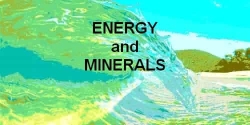Evaluation of Mineral Deposits
Evaluation of Mineral Deposits
When is a prospect a mine?
Factors that work together to make a mineral deposit "economic" (ie profit-making) :- current and future selling prices are forecast to remain the same or increase
- there is a market for the metal mined now and into the future and
someone willing to buy for the price you want to sell
- it is unlikely that another similar deposit elsewhere in the world will be able to come into production during the life of the mine and sell more cheaply
- taxes and rates of royalties will remain stable
- future interest rates on the millions you borrow can be reasonably predicted
- the country in which you produce is likely to remain on good terms with the country to whom you sell
- the banking sector looks strong (no global financilal crisis is looming)
- you are able to meet all the environmental constraints
- there is adequate transport in place to ship your product
- the minerals reserves are sound
- the metallurgy (ore to metal process) has been worked out
- the major shareholders are on-side
- a labour force and infastructure are in place
- a change in government will not affect your plans
This is why there is some urgency to get a deposit that is currently deemed "economic" into the market and selling while factors remain in the companies favour
Eventually, the results of all prospecting and exploration work are reviewed, evaluated and projected against the economic realities of production, marketing, environmental protection and other practical parameters. Economic appraisal plays a most important role in the development process as it forms both the basis for a decision to proceed with intensive exploration and, if accepted, a blueprint for future mine development. The most accurate and detailed measurements inevitably leave gaps that must be filled by prediction and the final decision to develop -- or not to develop -- is a human one, based upon present evidence and past experience.
The analysis or feasibility study looks to both the past and the future in drawing its conclusions. It is based on the results of the exploration programme and on engineering projections of production costs, types of equipment to be used and a host of other variables. Indeed, some factors, such as market trends, are at best a calculated guess. The estimated grade and quantity of ore in the ground is usually referred to as the geological reserve. But, since the total amount of ore present can be quite different from that which is extractable at a profit, a mining reserve is calculated which allows for economic conditions, limitations of the mining method and dilution of the mineral by waste rock.
A mining sequence or plan, based on various characteristics of the ore and surrounding rock, is also worked out. A metallurgical analysis is required to determine the most efficient separation process for a particular mineral. There are some minerals containing commercial metals for which no practical separation treatment now exists. The indicated metallurgical process is usually tested on a pilot scale so that the design requirements of a full-sized production plant can be accurately estimated.
With the mining and processing design in hand and the ore reserves indicated, the actual operating costs of an installation, its likely revenues, overall profitability and operating life can be estimated. The life of a mine is dependent not only on the size of the orebody but also on the rate at which the ore is removed. By balancing the costs of development and operation with revenues, a mining rate and the expected life of the operation can be calculated.
The revenues of a mine, to be derived from the sale of minerals, must be estimated from present and potential market values.
A projection of market trends should note possible variations in supply, demand and price. Events in many parts of the world can influence any of these factors: changes in taxation, tariffs or trade restrictions, for example, will affect the product's price and must be considered by planners. The results may indicate a need for caution, or alternatively, for haste in the mine's development.
The feasibility study is, then, a comprehensive analysis of the entire mine operation that takes everything into account from machinery and metallurgy to taxes and transportation. Sometimes, to add a final measure of thoroughness, not one but three different projections are made, using pessimistic, optimistic and probable assumptions of income and costs.
Many investors and developers have found to their sorrow that much enthusiasm and few facts are a good formula for mine failures. This is why time is devoted to the building of a reliable data base. From initial discovery to the first shipment of product from an operating mine can take up to eight years. Events such as market upsets, energy panics or political change can add to this time frame. Eventually the final question -- "Should the mineral occurrence be developed into a mine?" -- can be considered. This is the single, most critical decision that will be made, not only with regard to the future of the mine, but also for the business success of the developer and investor.

